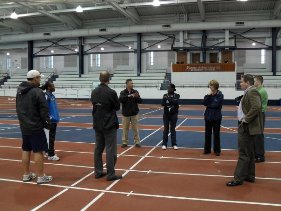2009 Program News
10/11/09: Week 4 Recap- Apprenticeships Completed, The Coaches Head to Colorado Springs
As Week 4 comes to a close, the ICECP coaches closed out their apprenticeship experiences and reunited at the US Olympic Training Center at Colorado Springs. The second week of the apprenticeships was as busy and productive as the first. Some coaches travelled with the teams they were working with, some visited new sites and facilities and some made big strides with their personal projects.
The basketball coaches continued their program in Philadelphia. They visited four more collegiate basketball programs, toured facilities, interacted with coaching staffs and observed team practices, individual workout and strength and conditioning sessions.
The five coaches made trips to St. Joseph’s University, Temple University, Villanova University and La Salle University, rounding out their visits to all of the Philadelphia Big 5 programs.
At St. Joe’s, they saw strength and conditioning workouts and individual skill drills for the men’s and women’s teams. At Temple, they had the chance to discuss training methodology, strategy and strength and conditioning with the staff of the defending Atlantic 10 conference champs.
At La Salle, the coaches watched team workouts and had quality interaction with the coaching staff. Head coach Dr. John Giannini also visited the coaches at their hotel for a question and answer session and some one-on-five interaction.
The visit to Villanova was the consensus favorite of the entire apprenticeship. At ‘Nova, the coaches took a tour of the Davis Center of Athletics and Fitness, the home of the men’s and women’s basketball programs.
They watched the intensity needed in a team practice for a program to advances to the NCAA Final Four. During the session they spoke with Keith Urgo, the director of basketball operations, about administrative tasks and details about the operations of a high-level program.
Afterwards, they had a chance to speak with head coach Jay Wright. They also met with the assistant coaches, and all of the players took time to introduce themselves to the ICECP visitors. Before they left, Misshame Anareme, a basketball coach from Togo, shot around with some of the players and got the feel of being on the practice floor with the Wildcats.
They finished their Philly experience by attending a Philadelphia 76ers NBA basketball game. The Sixers were down by 18 points late in the third quarter but engineered an impressive comeback to win by one after a field goal by Elton Brand with seven seconds left.
Overall, the apprenticeship experience was incredible for them.
“The Big 5 basketball programs and their facilities indicate the strong and deep support of their state and community.” Ripley said. “I can say now that Philadelphia is the ‘Soul of Basketball’.”
Also in Philadelphia, Egyptian national rowing team coach Rasha Ghoneim continued to work with the Penn AC Rowing Association. She attended morning and afternoon practices to see weight lifting sessions, training on the water and to grilled coach Dana Schmunk with every question she could think of. Schmunk also took Ghoneim to Princeton University to see the US national team training sessions.
Ricardo Torres, the national fencing coordinator in Peru, also continued his Philadelphia-based apprenticeship. He observed collegiate practices at UPenn under coach Andy Ma and classes for every level at the Fencing Academy of Philadelphia (FAP), run by coach Mark L. Maestro.
Torres was consistently impressed with Ma’s program, expertise and professionalism. He was also excited by the popularity of fencing in the US.
“I am very happy to know that there are 22,000 fencers affiliated to the USA Fencing Association. For me, it is a great and ambitious number to get for my country. Here, the universities give scholarships for fencing; it is amazing,” he said.
At FAP, Torres observed the training of beginner, intermediate and advanced fencers. He discussed athlete and grassroots development with the coaching staff there.
Halfway across Pennsylvania, the track and field coaches spent the week with multiple coaches at Penn State, including the leaders of the cross country, jumps, throwing and sprinting programs.
“We worked with coaches for different aspects of track and field each day,” said Denise Williams, the national track team coach in Grenada.
They also met with other members of the athletic department, such as the sport psychologist, and several elite athletes in the program, including the triple jumpers and steeplechasers.
 “The facilities were awesome; they have an amazing indoor track facility,” said Ernesto Selva, a national team coach in El Salvador. “The track has hydraulics, so they can add the banks for longer races and take them away for sprints.”
“The facilities were awesome; they have an amazing indoor track facility,” said Ernesto Selva, a national team coach in El Salvador. “The track has hydraulics, so they can add the banks for longer races and take them away for sprints.”
“The staff was very nice and so accommodating,” Williams said. “We were taken out to dinner on Thursday; they treated us great.”
Down in Miami, the judo coaches spent time with Panther Judo club, one of the largest clubs in the state.
“Panther JC is playing an exemplary role in the development of judo at the grassroots level,” said Igor Paskoski, the national team coach in Macedonia. The coaches saw how Panther raised and trained youth judokas.
Ian Weithers, the national team coach in Barbados, said that game theory was used to train the young judokas. They were taught technique through games and activities and by doing those activities each day, the proper technique was reinforced.
“It showed me that what I was doing at home was correct,” Weithers said.
Being at North Miami Judo Training Center and Panther JC also allowed the participants to see many nationally ranked judokas and observe their training regimes, and learn about the sport’s structure in the US.
To conclude their apprenticeship, the four judo coaches were treated to dinner by Chris and Pam McDonald, the founders and head coaches of Panther JC.
“At the dinner, so many things were discussed, like the uniqueness of US Judo, cooperation among judo clubs and the good coaching prowess of Jhonny Prado, German Valesco and the other judo coaches,” Paskoski said. “We also talked about the importance of judo as a tool of cultural exchange and benevolent foreign policy among nations and the state of affairs in world judo.”
Back in Delaware, Patricio F. Bridgewater continued working the Blue Hens’ volleyball program. And while he learned quite a bit about head coach Bonnie Kenny’s philosophy and training regime, the defending CAA champs may have learned a little more from him.
“Coach Kenny asked me what more she can do to train her players,” Bridgewater, the women’s national selection team coach in the Netherlands Antilles, said. “Some of my ideas were accepted and incorporated into their training. Two drills I showed them are now a part of their training regime every day.”
So when future UD players ask about the “Patrick Drill,” Bridgewater’s contribution to the program will be remembered. He had a positive effect on the team during his stay at Delaware. With Bridgewater around, the team was an impressive 5-0.
Those victories includes a big come-from-behind win over UNC, a hard-fought battle over conference foe Towson University and a back-and-forth nailbiter over Villanova on the road.
“If I could, I would stay two more weeks with Bonnie,” Bridgewater admitted. With those results, she surely feels the same.
 On the other side of the pond, Milos Tomic completed his apprenticeship with the US national ski team in Saas Fee, Switzerland.
On the other side of the pond, Milos Tomic completed his apprenticeship with the US national ski team in Saas Fee, Switzerland.
Tomic, the national team coach in Serbia, worked with the US team as they prepared for the Audi FIS World Cup opener, which is Oct 24-25 in Austria.
“The communication with the US national team coaches and athletes is perfect and sharing ideas and coaching philosophy is great,” he said.
He also noted that the team was excited and energized by the return of Bode Miller, a four-time world champion.
Out west, the archery coaches spent the first week of the apprenticeship in Chula Vista, CA, where they worked at the Eaton Aluminum Archery Range. The 50-lane outdoor complex is one of the largest in North America.
“The US Olympic archers are very professional in their training and the training center is an athlete's heaven,” said Edward Ramesar, the national team coach in Trinidad and Tobago.
For the second week, the trio moved to the Olympic Training Center at Colorado Springs to attend a coach’s clinic.
“We learned more about coaching philosophy, goals, training cycles, how to prepare archery equipment for disabled athletes and much more,” said Badamkhaton Tsogt, the national team coach in Mongolia.
Other topics included biomechanics, developing mental skills and planning and periodization of training. Archery experts and prominent coaches were on hand to run the course, including Kisik Lee of Korea. Lee is a five-time Olympic coach and trained Ramesar, Tsogt and Yu-Chiao Hsu of Chinese Taipei in his shooting technique.
“We had some sessions about the B.E.S.T. shot method with Mr. Kisik Lee. It's a new shooting style,” Tsogt said.
With their apprenticeships complete, the ICECP coaches gathered in Colorado Springs over the weekend. They have a free day on Sunday to prepare a presentation on their apprenticeship site, which will be given Monday.
While in the Springs, they will attend classroom sessions, expert presentations and take a few field trips. Destinations include the Carmichael Training Systems site, the National Strength and Conditioning Association site and a tour of the US Air Force Academy’s athletic facilities.
They will also meet with their tutors to complete the first draft of their projects. Presentations of the programs they plan to implement upon returning home will be given Oct 24.
With plenty of work ahead, the coaches are taking time to relax, recounting experiences with each other from their time apart and appreciating the opportunity they have in ICECP.
“This is truly a program I am thankful to be a part of,” Ripley said. “It gives me a stronger sense of being on the right track with my ambition and passion and for my love of my sport.”



